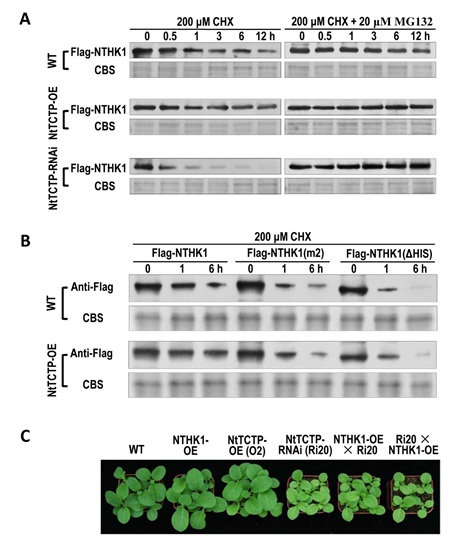As an important phytohormone, ethylene is known to participate in controlling fruit ripening, organ senescence and plant responses to stresses. In addition, ethylene also regulates vegetative growth. So far, a linear model for ethylene signal transduction has been established in Arabidopsis based on the classical “triple response”. As for ethylene receptors, beyond the functional redundancy, more and more unique roles of different receptor members have been being discovered.
Previously, the family II ethylene receptor NTHK1 in tobacco was cloned in Drs ZHANG Jinsong and CHEN Shouyi’s lab in the Institute of Genetics and Developmental Biology, Chinese Academy of Sciences. It was found that NTHK1 possess Ser/Thr kinase activity and participates in regulating seedling growth and plant response to salt stress (Xie et al., 2003, Plant J; Cao et al., 2007, Plant Physiol; Chen et al., 2009, Plant Cell Physiol).Then, two NTHK1-interacting proteins NEIP2 and NtTCTP were screened out by yeast two-hybrid assay.NEIP2 was found to associate with NTHK1 to regulate leaf growth and plant response to salt stress, and protein phosphorylation is likely involved in (Cao et al., 2015, Plant Cell Physiol).
Their latest study on another NTHK1-interacting protein NtTCTP demonstrated that ethylene induces the accumulation of NtTCTP protein and promotes the interaction between NtTCTP and NTHK1, so to enhance their co-localization at ER membrane. Phenotypic analysis showed that both NTHK1 and NtTCTP regulate plant vegetative growth mainly through controlling cell proliferation. A series of biochemical, cytological and genetic analysis indicated that NtTCTP inhibits the proteasome-mediated decay of NTHK1 by direct interaction with it, thus stabilizing NTHK1 protein and reducing plant response to ethylene (Figure 1).
Their study reveals a novel negative feedback mechanism of tightly restraining excessive ethylene response and promoting growth recovery from inhibited growth. In this model, NtTCTP acts as a brake of ethylene signaling and an enhancer of cell proliferation to coordinate normal vegetative growth and ethylene response.
This work has been published online on May 4, 2015, in Plant Physiology (DOI: 10.1104/pp.15.00355). Dr. TAO Jianjun and Dr. CAO Yangrong Cao are the co-first authors of this paper.
This work is supported by the National Natural Science Foundation of China, the National Key Basic Research Project, and the State Key Lab of Plant Genomics.

Figure 1. NtTCTP inhibits ethylene receptor NTHK1 from proteasome-mediated degradation and promotes plant growth. (Image by IGDB)
(A) NtTCTP inhibits ethylene receptor NTHK1 from proteasome-mediated degradation. Flag-NTHK1 was expressed in tobacco leaves of WT,NtTCTP-overexpressing line (O2) andNtTCTP-silencing line (Ri20) through agrobacterium-mediated transformation. After expression for 2 d, leaves were treated with 200 μM CHX or 200 μM CHX plus 20 μM MG132 for different times and the flag-NTHK1 protein was detected by immunoblotting with anti-flag antibody.
(B) The direct interaction is necessary for NtTCTP to stabilize NTHK1. Kinase-inactivated mutation (m2) (reducing the interaction between NTHK1 and NtTCTP) and His-truncated (ΔHIS) (eliminating the interaction) types of NTHK1 were used for the protein stability assay. Agrobacterium-mediated transformation, CHX treatment and immunoblotting were performed as described in (A).
CBS: Coomassie blue staining of the protein.
(C) Phenotypes of the F1 hybrids compared with the WT and other tobacco lines. The F1 hybrids between NTHK1-OE and NtTCTP-RNAi showed similar phenotypes on seedling size to theNtTCTP-silencing line (The 34-DAS-old seedlings of different tobacco lines growing in soil were photographed).
NTHK1-OE, theNTHK1-overexpressing line; NtTCTP-OE,NtTCTP-overexpressing line O2; NtTCTP-RNAi,NtTCTP-silencing line Ri20. |



